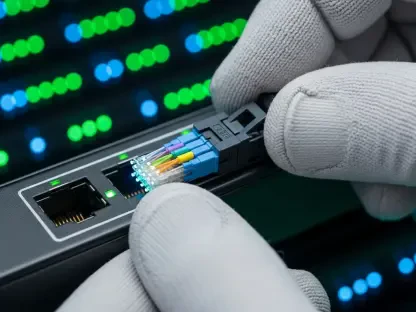In an era where digital connectivity forms the backbone of nearly every aspect of modern life, the importance of maintaining robust network infrastructure cannot be overstated. Local Area Network (LAN) cable testers, specialized devices designed to ensure the integrity and functionality of network cables, have emerged as indispensable tools across residential, commercial, and industrial environments. As businesses, governments, and individuals increasingly rely on seamless internet access and data transfer, the demand for reliable testing solutions is skyrocketing. This market, which stood at $656.6 million in 2024, is projected to climb to $693.4 million this year and reach an impressive $1,200 million by 2035, reflecting a steady Compound Annual Growth Rate (CAGR) of 5.6% over the next decade. Such growth signals a broader trend of digitalization, where preventing network downtime is not just a technical need but a strategic priority. This trajectory raises critical questions about the forces driving this expansion and the challenges that lie ahead in an increasingly connected world.
Market Growth and Key Drivers
Rising Demand for Reliable Connectivity
The relentless expansion of global network infrastructure stands as a primary catalyst for the burgeoning LAN cable tester market. With businesses digitizing operations, governments enhancing communication systems, and individuals embracing online platforms for work and leisure, the need for uninterrupted connectivity has never been more pressing. LAN cable testers play a vital role in this ecosystem by identifying faults such as cable breaks or miswiring, ensuring that networks operate at peak efficiency. This demand is particularly pronounced in sectors like telecommunications and corporate IT, where even minor disruptions can lead to significant financial losses. As digital dependency grows, the market for these testing tools is expected to see sustained momentum, fueled by the sheer volume of network installations worldwide. The emphasis on reliability underscores a fundamental shift: maintaining connectivity is no longer optional but a cornerstone of economic and social progress in today’s landscape.
Another dimension of this rising demand lies in the proliferation of smart technologies across diverse settings, which is transforming how we interact with our environments. From smart homes equipped with IoT devices to industrial facilities adopting automation, the complexity of network systems is increasing exponentially. Each new device or system adds layers of potential failure points, making rigorous testing essential to prevent costly downtime. LAN cable testers, therefore, are becoming integral not just for large enterprises but also for smaller entities and households entering the digital fold. This broadening user base highlights how connectivity challenges transcend traditional boundaries, affecting everyone from tech giants to individual consumers. As a result, the market is witnessing a surge in demand for testing solutions that can cater to varied scales and complexities, reflecting a universal push toward seamless digital integration over the coming years.
Technological Innovations
Advancements in technology are reshaping the landscape of LAN cable testers, transforming them from basic diagnostic tools into sophisticated instruments packed with cutting-edge features. Modern testers now boast digital displays for clear readouts, automatic fault detection for rapid issue identification, and even tone generation to trace cables in crowded setups. Integration with mobile applications further enhances usability, allowing technicians to monitor and analyze network performance remotely. These innovations not only improve accuracy but also make the tools accessible to a wider audience, including non-specialists in residential or small business environments. As technology continues to evolve, the functionality of these testers is expected to keep pace, ensuring they remain indispensable in maintaining the integrity of increasingly complex networks across various sectors.
Beyond enhancing usability, technological progress is also driving market growth by addressing specific pain points in network maintenance. For instance, the ability to detect subtle signal interference or predict potential failures before they occur represents a significant leap forward in preventive care for digital infrastructure. Such capabilities reduce the risk of unexpected outages, saving time and resources for organizations that depend on constant uptime. Additionally, the incorporation of cloud-based analytics into some testers allows for data storage and trend analysis, providing deeper insights into network health over time. This shift toward smarter, more connected testing solutions mirrors broader trends in digital transformation, where efficiency and foresight are paramount. The market’s response to these innovations suggests a future where LAN cable testers will play an even more critical role in sustaining connectivity.
Infrastructure Investments
Massive investments in data centers and urban IT projects are significantly bolstering the demand for LAN cable testers, as these facilities form the core of modern digital ecosystems. With the exponential growth of cloud computing and big data, data centers require flawless network performance to handle vast amounts of information without interruption. Testers are essential in this context, ensuring that every cable connection meets stringent standards to avoid bottlenecks or failures. Similarly, urban areas undergoing rapid digital transformation are deploying extensive network systems to support smart city initiatives, further amplifying the need for reliable testing tools. These investments signal a global recognition of digital infrastructure as a critical asset, positioning LAN cable testers as key components in minimizing disruptions and optimizing operational efficiency.
Moreover, the scope of infrastructure projects extends beyond data centers to include educational institutions, healthcare facilities, and government offices, all of which rely on robust networks for daily operations. As these sectors modernize, the complexity and scale of their network installations grow, creating additional demand for testing solutions that can handle diverse challenges. LAN cable testers help ensure that new installations are error-free and that existing systems remain functional under increased loads. This widespread adoption across public and private sectors illustrates the market’s integral role in supporting broader economic and societal advancements. With billions being poured into digital infrastructure globally, the trajectory of this market appears closely tied to the pace of such developments, promising sustained growth as connectivity becomes ever more embedded in everyday life.
Market Segmentation and Applications
Diverse Testing Needs
The LAN cable tester market is characterized by a nuanced segmentation that addresses a wide spectrum of user requirements, ranging from basic troubleshooting to intricate enterprise-level diagnostics. At the simplest level, continuity testers offer straightforward checks for cable connectivity, ideal for small-scale or residential use. Advanced multifunctional testers, on the other hand, provide detailed insights into issues like signal strength and interference, catering to mid-sized businesses with more complex networks. At the high end, professional network analyzers serve large-scale operations such as data centers, delivering comprehensive performance assessments. This tiered approach ensures that the market can meet varying technical demands, making LAN cable testers versatile tools across different contexts and user capabilities, while also driving adoption by aligning products with specific needs.
Another aspect of this segmentation lies in the adaptability of testers to evolving network standards and technologies. As networks transition to higher speeds and greater bandwidths, testing equipment must keep up with new protocols and configurations to remain relevant in a fast-changing environment. Manufacturers are responding by designing testers that are not only backward-compatible but also future-proof, capable of handling emerging requirements. This flexibility broadens the market’s appeal, as users can invest in tools with confidence that they won’t become obsolete quickly. Furthermore, the range of available testers allows for scalability, enabling users to upgrade from basic to advanced models as their network needs grow. Such diversity in product offerings reflects a deep understanding of the market’s heterogeneity, ensuring that solutions are accessible to everyone from individual homeowners to sprawling corporate entities over the forecast period.
Sector-Specific Growth
The dominance of the IT and telecommunications sector in the LAN cable tester market comes as no surprise, given its unrelenting need for network optimization and fault detection to support critical operations. These industries rely on testers to maintain vast, intricate systems that underpin global communication and data transfer, where even minor issues can cascade into major disruptions. The high stakes involved drive significant investment in testing tools, ensuring that network reliability remains uncompromised. This sector’s influence on the market is evident in the push for advanced testers equipped with features tailored to large-scale, high-speed environments, highlighting how integral these tools are to sustaining the backbone of digital economies worldwide. The consistent demand from IT and telecom continues to shape market trends and innovation.
Meanwhile, a notable surge in residential demand is reshaping the market’s dynamics, fueled by the widespread adoption of smart home technologies and IoT devices. Homeowners increasingly depend on stable networks to power everything from security systems to entertainment hubs, creating a need for user-friendly testing tools that can diagnose common issues without requiring technical expertise. This shift expands the market’s reach beyond traditional commercial applications, tapping into a growing consumer base eager for connectivity solutions. Additionally, small businesses adopting digital tools for operations contribute to this trend, seeking affordable yet effective testers to maintain their networks. The convergence of residential and small-scale commercial growth illustrates the market’s adaptability, as it evolves to serve an ever-widening array of users with distinct yet interconnected needs.
Regional Dynamics and Opportunities
Leading and Emerging Markets
North America holds a commanding position in the LAN cable tester market, driven by early adoption of cutting-edge networking technologies and a well-established industrial and commercial infrastructure that supports rapid growth. The region benefits from the presence of major industry players who continuously innovate to meet the high demand for reliable connectivity solutions. Robust investments in data centers and corporate networks further solidify North America’s lead, as businesses prioritize uptime and efficiency. This dominance reflects a mature market where testing tools are deeply integrated into network maintenance practices, setting a benchmark for technological standards and adoption rates. As a result, the region serves as a critical hub for market developments, influencing global trends in product design and deployment strategies over the coming years.
In stark contrast, the Asia-Pacific region emerges as the fastest-growing market, propelled by rapid urbanization and substantial investments in IT infrastructure, which together create a powerful engine for technological advancement. The rise of small and medium enterprises adopting digital solutions in countries across this region fuels demand for cost-effective yet reliable LAN cable testers. Additionally, government initiatives to build smart cities and expand broadband access amplify the need for network testing tools to support new installations. This growth trajectory highlights Asia-Pacific’s potential to outpace other regions, as economic development and technological uptake create a fertile ground for market expansion. The disparity between North America’s established dominance and Asia-Pacific’s dynamic rise underscores the varied paces of digital transformation globally, shaping a diverse market landscape.
Localized Challenges and Potential
Regional disparities in technological adoption and economic conditions present unique challenges for the LAN cable tester market, particularly in emerging areas. In many developing regions, limited financial resources restrict access to advanced testing equipment, slowing market penetration despite growing network needs. Additionally, a lack of technical expertise to operate complex testers can hinder effective implementation, especially in areas with underdeveloped training infrastructures. These barriers are compounded by inconsistent regulatory frameworks that may delay the introduction of new products or technologies. Addressing such localized issues will be crucial for manufacturers aiming to tap into these markets, requiring tailored strategies that account for economic and skill-based constraints while still delivering value.
Despite these hurdles, emerging regions like the Middle East offer significant untapped potential for market growth, driven by ongoing infrastructure projects and a push toward technological modernization. Large-scale developments, such as smart city initiatives and industrial expansions, create a pressing need for reliable network testing solutions to support ambitious digital goals. The relatively low saturation of advanced testers in these areas presents an opportunity for companies to establish a foothold by offering affordable, user-friendly products. Success in these markets will depend on balancing innovation with accessibility, ensuring that solutions meet local demands without overwhelming users with complexity or cost. This potential for expansion in less saturated regions highlights the global scope of the market, promising new avenues for growth as digitalization continues to spread.
Challenges and Competitive Landscape
Barriers to Adoption
One of the most significant obstacles facing the LAN cable tester market is the high cost of advanced testing equipment, which can deter adoption among small businesses and budget-constrained projects. In emerging markets, where financial resources are often limited, the price of sophisticated testers creates a barrier to entry, slowing the pace of market expansion. This issue is particularly acute for multifunctional or professional-grade devices that offer comprehensive diagnostics but come with a steep price tag. As a result, many potential users may opt for cheaper, less reliable alternatives or forego testing altogether, risking network failures. Overcoming this cost barrier through innovative pricing models or scaled-down versions of advanced tools will be essential to broadening the market’s reach and ensuring inclusivity across diverse economic landscapes.
Another pressing challenge is the proliferation of low-cost counterfeit products that undermine market credibility and reliability, as these substandard testers often fail to deliver accurate results, leading to undetected network issues and potential damage to legitimate manufacturers’ reputations. This problem is especially prevalent in regions with lax regulatory oversight, where distinguishing between genuine and fake products can be difficult for consumers. Furthermore, the technical complexity of operating advanced testers poses a hurdle, as it demands specialized training that may not be readily available in all areas. Without adequate skills, users struggle to maximize the tools’ potential, limiting their effectiveness. Tackling these challenges through quality assurance, educational initiatives, and accessible design will be critical to sustaining trust and growth in this competitive field.
Innovation and Market Strategies
In a crowded LAN cable tester market, leading companies are leveraging research and development to stay ahead, focusing on enhancing product performance with cutting-edge features. Innovations such as AI-driven fault detection and IoT-enabled remote monitoring are setting new standards, appealing to tech-savvy users seeking efficiency. Beyond product upgrades, strategic partnerships with network infrastructure providers enable firms to expand their reach and integrate testers into broader connectivity solutions. These collaborations often result in bundled offerings that add value for customers, strengthening brand positioning. The emphasis on innovation reflects a market where staying relevant requires constant adaptation to technological trends and user expectations, ensuring that companies remain competitive over the long term.
Pricing strategies and product diversification play pivotal roles in differentiating companies within this dynamic landscape, allowing them to stand out in a competitive market. Balancing affordability with advanced functionality enables firms to cater to a wider audience, from cost-conscious small businesses to large enterprises seeking premium tools. Robust customer support further enhances competitiveness, as timely assistance and training can significantly improve user experience and loyalty. As the market evolves, companies that prioritize a customer-centric approach alongside technological advancements are likely to gain a significant edge. This focus on strategic adaptability underscores the importance of understanding diverse market needs, ensuring that solutions are both innovative and accessible to drive sustained growth through 2035.
Future Outlook and Strategic Pathways
Emerging Technologies and Market Evolution
Looking toward the horizon, the integration of smart technologies like artificial intelligence and the Internet of Things into LAN cable testers promises to redefine industry standards. AI-driven features, such as predictive analytics for potential network failures, can transform testers into proactive tools rather than reactive ones, enhancing efficiency for users across sectors. IoT connectivity enables cloud-based monitoring, allowing real-time data access and long-term performance tracking from any location. These advancements are poised to streamline network maintenance, reducing downtime and costs for businesses and individuals alike. As these technologies mature, they will likely become more accessible, broadening their adoption and pushing the market toward new heights of innovation and user engagement in the years leading to 2035.
Additionally, the rollout of 5G networks and the expansion of cloud computing are set to intensify network demands, further driving the need for precise testing solutions. High-speed, low-latency 5G systems require flawless cable performance to deliver on their potential, placing LAN testers at the forefront of this technological shift. Similarly, the growing reliance on cloud services means data centers must maintain impeccable connectivity, amplifying the market’s relevance. Companies that align their offerings with these trends, developing testers compatible with next-generation networks, stand to capture significant market share. This convergence of emerging technologies with testing needs highlights a future where LAN cable testers evolve into critical enablers of digital progress, supporting the infrastructure of tomorrow’s connected world.
Navigating Growth with Actionable Solutions
Reflecting on the market’s journey, the steady climb toward a $1,200 million valuation by 2035 was underpinned by a relentless focus on connectivity and digital transformation, showing how determination and innovation can drive growth in a competitive landscape. Challenges like high costs and counterfeit products were met with strategic responses, as industry players adapted to ensure broader access and reliability. The past decade saw remarkable strides in technology, with smart features becoming integral to testing tools, while regional disparities prompted tailored approaches to market penetration. This period demonstrated the market’s resilience, as it navigated economic and technical hurdles to cement its role in sustaining global networks.
Looking ahead, actionable steps will be vital to capitalize on this foundation, ensuring that the industry can build on its current strengths and address future challenges effectively. Manufacturers should prioritize developing cost-effective testers without compromising quality, ensuring accessibility for emerging markets. Investing in user education to bridge skill gaps can enhance adoption of advanced tools, while robust anti-counterfeiting measures will protect market integrity. Embracing partnerships to integrate testers into broader digital ecosystems offers another pathway to growth. As 5G and IoT continue to shape connectivity, aligning innovation with these trends will position the market for sustained success, opening new frontiers for expansion and impact.









